

Introduction
The Canon EOS R7 is a new high-end mirrorless camera aimed predominantly at enthusiast wildlife and sports photographers.
It has a 32.5 megapixel APS-C CMOS sensor, the joint highest resolution ever found in a Canon cropped sensor mirrorless camera, which is partnered with the very latest Digic X processor.
This is a fast camera – 15fps burst shooting is available when using the R7’s mechanical shutter and 30fps when using the electronic shutter, both with continuous auto-focus and auto-exposure.
The native ISO range runs from 100-3200, which can be expanded to ISO 51200, and the top shutter speed is 1/16,000sec when using the electronic shutter.
Thanks to its Digic X processor and Dual Pixel CMOS AF II autofocus system, the EOS R7 offers the same deep-learning artificial intelligence based automatic face, eye, animal and vehicle AF tracking modes as the full-frame R3, R5 and R6 models.
On the video side, there’s 4K/60p recording with no crop for up to an hour and Full HD footage at frame rates up to 120p plus support for Canon Log 3, which potentially makes the Canon R7 just as appealing to videographers as to stills photographers.
There is up to 8-stops of image stabilisation available via a combination of the camera’s in-body Image Stabiliser which works in tandem with the attached lens’ own stabilisation system.
The weather-resistant Canon R7 features a 3-inch 1,620K-dot LCD vari-angle monitor with a touch-screen interface and an integrated OLED electronic viewfinder with 2.36M dot resolution, magnification of 1.15x and 120fps refresh rate.
There’s also an innovative new combined AF point selector, dual UHS-II SD memory card slots, built-in Wi-Fi and Bluetooth connectivity, integrated USB Type-C, mini HDMI, headphone, microphone ports and a new multi-function accessory shoe.
The Canon EOS R7 is priced at £1,349.99 / €1,649.99 / $1,499.00 body only in the UK, Europe and USA respectively. It is made in Japan.
Ease of Use
Intended to be the spiritual successor to the popular EOS 7D Mark II DSLR, the new Canon R7 is specifically targeted at sports and wildlife photographers and videographers who prioritise speed of shooting and operation.
Along with the R10 model that was announced at the same time, the EOS R7 is the first ever Canon APS-C sensor mirrorless camera to use the same RF lens mount as the company’s full frame cameras.
This is the main differentiator between these two new R-series models and the existing EOS M-series, which use a different EF-M lens mount.
Consequently, you can either use Canon’s equally new range of RF-S lenses which are designed specifically for the R7 and R10 (and all future Canon R-series APS-C cameras), or you can use the more established full-frame RF lenses, with an accompanying change in the focal length due to the 1.6x crop factor involved with mounting full-frame lenses on an APS-C sensor.
In addition, Canon’s huge number of EF and EF-S DSLR lenses can be used with the R7 and R10 by attaching the optional EF-EOS R Mount Adapter, which is very handy if you already have a large collection of legacy lenses.
What you can’t do, sadly, is use the EF-M lenses that were designed for the EOS-M system on the R7/R10, which means that there’s no clear upgrade path for users of Canon’s first APS-C sensor mirrorless system other than to start over again.

It also means that there aren’t very many lens options for the R7 and R10 from day one – Canon only released two rather uninspiring lenses alongside the new bodies, the super-compact RF-S 18-45mm F4.5-6.3 IS STM standard zoom which has a collapsible design and the more versatile RF-S 18-150mm F3.5-6.3 IS STM zoom.
Both lenses commendably have built-in optical stabilisation and don’t cost the earth, but the maximum apertures are very slow and neither are particularly wide. They’re fine if you’re just starting out and don’t already own any compatible Canon lenses, but we’d hope to see some more inspiring RF-S lenses launched as soon as possible in order to compete on a more level playing field with the likes of Sony and especially Fuji film.
The 32.5 megapixel, high-resolution sensor in the Canon EOS R7 is great news for those who want to get the most detail possible from their shots.
If you’re somebody who likes to shoot macro images, for example, you’ll be able to reproduce more detail than was previously available before from most Canon APS-C cameras.
There are two exceptions – the 3-year-old EOS 90D DSLR and EOS M6 Mark II mirrorless models both used exactly the same 32 megapixel sensor as the new R7, although they only featured the Digic 8 processor rather than the latest and greatest Digic X processor that the R7 benefits from.
JPEGs directly from the R7 are very pleasing, with excellent vibrant colours which are just the right side of realistic. On the whole, automatic white balance does a good job of keeping colours in check in a variety of lighting conditions, while the all-purpose evaluative metering system works well to produce balanced exposures.

As Canon’s metering system weights exposure towards the active AF point, you might find in certain high-contrast situations, you need to switch to spot metering for best results, but for most everyday situations it’s a great performer.
The ISO range runs from 100-32,000, which can be further expanded up to ISO 51,200.
The EOS R7 is the latest Canon camera to support Dual Pixel RAW. This allows correction of the focus and contrast in the background using the Background Clarity mode and changing the lighting in portraits via the Portrait Relighting mode after capture, just using your finger/thumb on the EOS R7’s touchscreen LCD.
The Canon R7 features exactly the next generation Dual Pixel CMOS AF II focusing system as used by the flagship R3 and R5 full-frame cameras.
It has 651 automatic focus points and 5,915 manually selectable AF points, which is slightly less than the EOS R3, R6 and R5, with similar 100% frame coverage in Auto selection mode and 90% vertical and 100% horizontal in manual selection.
Impressively the EOS R7 can focus in light levels as low as -5EV (when used with an F1.2 lens) or with maximum apertures as small as f/22, which enables autofocus even when using ultra telephoto lenses with teleconverters.
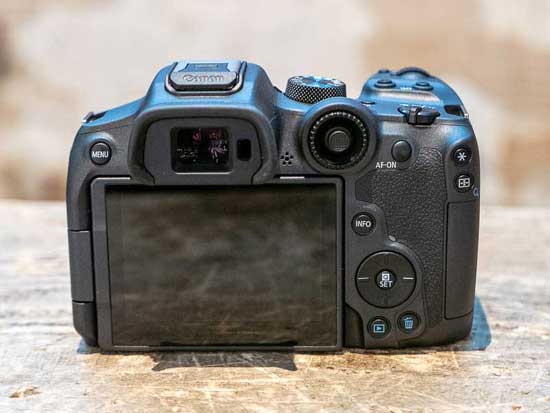
Shutter speeds as fast as 1/8000s are supported using the mechanical shutter and up to 1/16000s using the electronic shutter.
Thanks to its Digic X processor, the EOS R7 offers exactly the same deep-learning artificial intelligence based automatic face, eye and animal AF tracking modes as the R3, R5 and R6 models.
Therefore Canon R7 can recognise and track eyes from much further away than previous models, and it works even if the person is wearing a mask, helmet or sunglasses. Subject tracking works for humans and also dogs, cats and birds, the latter even in flight.
The EOS R3 also has the ability to track vehicles, including cars and motorbikes. What’s more, if the driver is wearing a helmet, the AF system will lock on to that, ensuring that the most important subject is in focus.
Turning to R7’s the headline-grabbing continuous shooting speeds, the camera can shoot at a blistering 30fps when taking advantage of the silent electronic shutter, complete with full AF and AE tracking,, exactly the same rate as the flagship EOS R3 camera.
What’s more, the new R7 actually betters the R3 if you prefer to use the mechanical shutter, offering a burst rate of 15fps versus the R3’s slower 12fps.
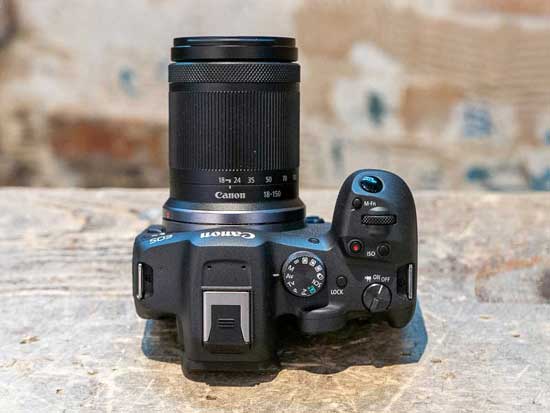
The buffer “only” allows bursts of up to 224 JPEG or 51 RAW images when using the mechanical shutter or 126 JPEG or 42 RAW images when using the electronic shutter, though, neither of which match up to the R3’s much larger 540 JPEG or 150 RAW frame buffer.
Still, being able to continuously shoot 42 x 32 megapixel RAW files at 30fps or over 4 seconds of full-sized JPEG files at the same rate using a completely silent shutter should certainly please all but the pickiest of customers.
To cope with all of that data and to provide more recording flexibility, the camera has dual UHS-II SD card slots.
While that greatly expands the choice of memory cards that can be used with this camera, we would have preferred at least one CFexpress slot instead of the exclusively SD card approach, as burst shooting speeds are much slower when recording to SD cards than to CFexpress.
In-body stabilisation is one of the key benefits of mirrorless versus DSLRs in general and also one of the key technological advances that the R7 has made since the launch of the EOS 7D Mark II way back in 2014.
It has been designed to work collaboratively with the IS system that’s built into many RF- and RF-S-mount lenses, with the lens and the sensor working together to correct pitch and yaw and the sensor correcting the X-Y and roll movements. The IBIS system also supports automatic horizon correction for the first time on a Canon camera.
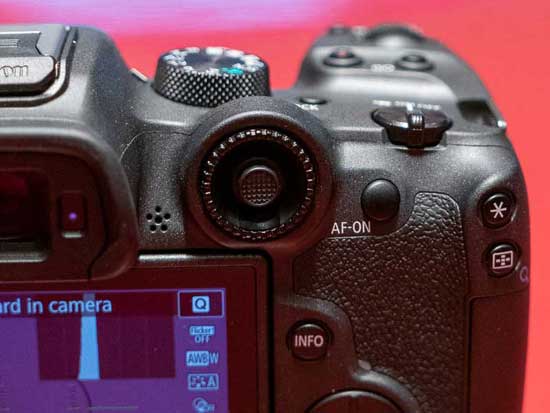
This intelligent stabilisation system provides 7-stops based on the CIPA standard with the RF-S 18-150mm F3.5-6.3 IS STM at a focal length of 150mm, and a frankly incredible 8-stops of stabilisation with some lenses, allowing you to hand-hold the camera for up to 4 seconds and still get critically sharp results.
The EOS R7 can also stabilise older, non-IS lenses including any EF lens that is mounted on it via the Canon EF-EOS R mount adapter.
The stabilisation system will also work with lenses from other manufacturers – you just need to input the focal length into the camera’s menu system.
In practice, the EOS R7’s stabilisation system is excellent, making it possible to hand-hold the camera at previously impossibly slow shutter speeds and still maintain critical sharpness.
File format wise, the R7 is Canon’s latest EOS camera to support the ‘next generation’ HEIF (High Efficiency Image File) file format, enabling images with 10-bits of data to be saved in a file the equivalent size of a JPEG, while suffering less compression.
Of course Raw files can be shot in tandem with JPEGs (or indeed HEIF files) as per usual – here with Canon’s own .CR3 (Canon Raw) file extension, which requires the likes of Photoshop or Lightroom to access and open.
The Canon R7 offers the ability to record uncropped 4K UHD / 60p / 10-bit footage internally with dual-pixel auto-focus and auto-exposure for up to 60 minutes.
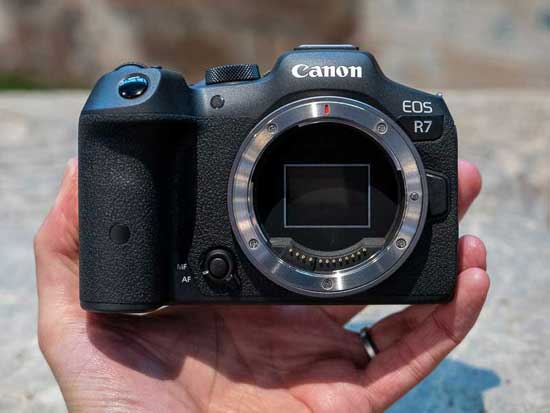
There’s also a special 4K/30p Fine mode which oversamples from 7K for the ultimate image quality, and also a dedicated 4K/60p UHD crop mode for extra telephoto reach (55% of the horizontal area).
Full 1080 slow-motion recording at up to 120p with autofocus is also available (but no sound), which is actually something that the flagship EOS R5 doesn’t offer.
The intentionally flat Canon Log 3 colour profile is available to provide extra flexibility for colour grading in post-production.
Both live streaming and vertical video capture are supported, the latter being ideal for reels and stories.
Canon have also included zebra display during movie shooting, which can be used as a guide to exposure adjustment, especially for highlights.
The EOS R7 utilises a similar polycarbonate shell to the one found on the EOS R6 rather than a magnesium-alloy body as used by the more expensive R7.
Canon say that it offers similar levels of weather-proofing to 2019’s EOS 90D DSLR, which means that it’ll be fine in a light rain shower but will need protecting in a heavier downpour. Note that the two new RF-S zoom lenses are not similarly weather-proof.
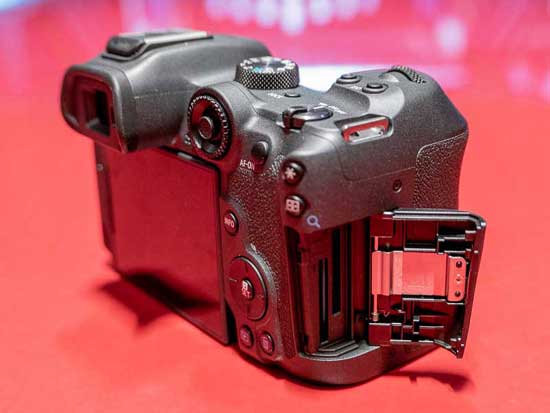
It measures 138.5 x 97.5 x 88mm, making it quite a lot smaller than the Canon R5 and R6, and it’s significantly lighter too, weighing in at 530g body-only or 612g with both a battery and memory card fitted.
Despite its smaller stature, the Canon R7 benefits from having a deep handgrip that just about accommodates four fingers, something that can’t be said of many of its main rivals.
The minimalist front plate houses two controls. There’s an unmarked Function button that can be customised, including controlling the auto-focus. By default it activates the classic Depth of Field preview function, which helps you determine what your photos will look like before the image is taken.
This button is encircled by the MF/AF mode switch, which is especially welcome as the two new RF-S lenses both lack this handy switch. There’s also a porthole for the AF assist light and a lozenge shaped button for releasing the lens.
The new Canon EOS R7 has a very similar top plate layout to the EOS R6 full-frame model.
There is a conventional shooting mode dial on the right-hand side to change the shooting mode, with the usual P, Tv, Av and M options, Bulb mode, three Custom modes, 10 different Creative Filters, and three options for less experienced users – a selection of Scene modes, the set-everything Scene Intelligent Auto mode, and Flexible-Priority AE mode, which bridges the gap between full auto and the PASM modes.
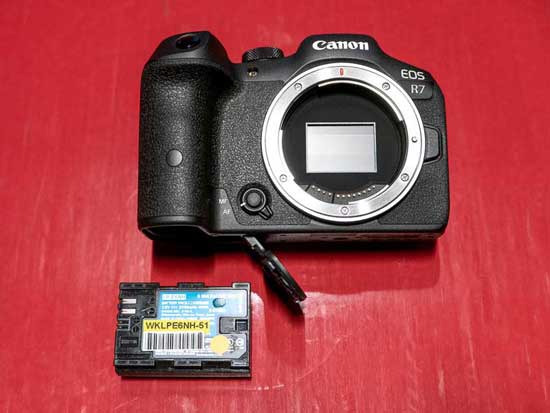
Both a shooting mode dial and a top-plate LCD screen would be ideal, but EOS R-series camera bodies are simply too small to accommodate them together, with the R7 being no exception.
There’s a small Movie/On/Off switch over on the far-right, with the camera leaping into life almost instantly. The camera remembers separate settings for each of the Movie and On/Stills settings.
Providing quick access to the video settings via this is a good idea, although I did inadvertently push it too far quite a few times when trying just to select On / stills mode and ended up in the movie mode instead.
There’s a small but responsive shutter release button at the top of the handgrip, with the tiny M-Fn behind it. This provides quick access to some of the camera’s key controls, including ISO, continuous shooting, AF, white balance and exposure compensation.
Behind that is the front control dial for principally setting the aperture or shutter speed, and behind that a small, red one-touch movie record button and an equally small ISO button sitting proud of the camera body.
The final control is the Lock button which as its name suggests locks the two control dials on top of the camera and the rear control wheel so that you can’t accidentally change the camera’s key settings.
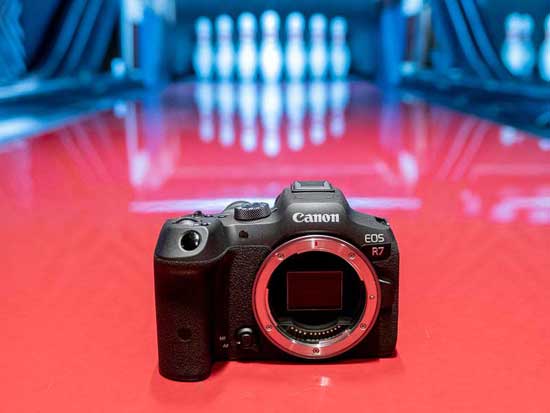
Rather than also having a second control dial on the top-plate that’s ideally placed for thumb operation, as on the EOS R6 and other R-series models, the R7 sees the debut of the combined AF point selector and rear control wheel at the top-rear of the camera body.
This amalgamates the popular scrolling control wheel from both many Canon DSLRs and the R5/6, which usually encircled the Set button, with the AF joystick in a kind of hybrid control that’s operated with your right thumb.
We like the fact that the new scroll wheel reduces redundancy by being used for both setting the aperture and shutter speed and also for quickly scrolling through the menu system and during image playback (the one on the EOS R6 actually serves less purpose than the one on the EOS R7 because there are already two control dials on top of that camera for setting the aperture and shutter speed).
While the inclusion of the joystick is very welcome, we were struck by just how high the joystick is positioned. It’s inline with the centre of the viewfinder, rather than where the Magnification button is, which at least initially seems rather too high to find easily, especially compared with most other cameras that have this key control. We eventually got used to it higher position, but still can’t help wishing that it was lower down.
Also, its location within the middle of the scroll wheel makes it harder to locate in a hurry, especially if you have larger hands, and on a few occasions I also inadvertently activated the scroll wheel whilst only trying to operate the AF joystick, which unfortunately affected the exposure settings. It’s definitely a rather marmite control that some will love and others may well hate.
The Menu bottom on the far left is the only control found on this side of the back-plate.
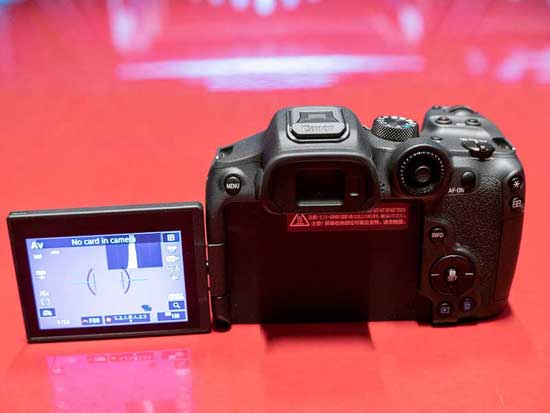
The new Multi-Function Shoe provides data communication and power for accessories such as the ST-E10 Speedlite Transmitter, DM-E1D Stereo Microphone, and AD-P1 Smartphone Link Adapter, as well as acting as a traditional hotshoe for existing Speedlites and triggers via the AD-E1 Multi-Function Shoe Adapter.
The 0.39 inch, 2.36 million dot EVF on the EOS R7 isn’t the most cutting-edge technology wise, but it’s still fairly impressive to look through, working up to 120fps for minimal lag when shooting fast-moving subjects and offering a large magnification of 1.15x.
The EOS R7 has the same 3-inch, 1.62 million dot, vari-angle LCD screen as the R6, which tilts out to the side and faces forwards for more convenient vlogging and selfies. It’s fine but beginning to show its age now.
It can be usefully folded flat against the back of the camera to protect it when in transit in a camera bag.
A proximity sensor is located directly beneath the viewfinder, which automatically switches between the EVF and LCD screen. When the LCD screen is swung outwards, the EVF is cleverly turned off automatically.
A tilting LCD screen always helps to encourage shooting from creative angles and it also helps make the EOS R7 ideally suited to movie-shooting.
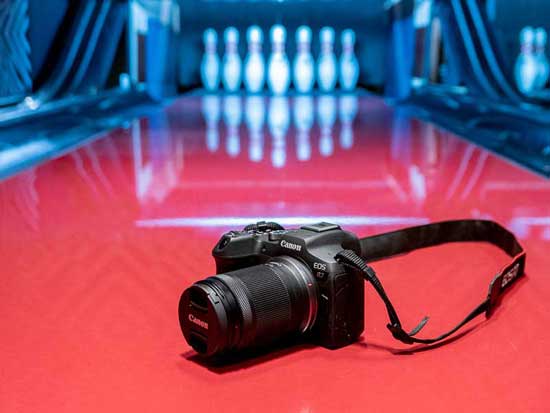
The LCD screen is touch-sensitive, allowing you to control everything from setting the AF point and firing the shutter, navigating the menu systems and browsing your images during playback. It’s a very precise, responsive system that’s a veritable joy to use.
Alongside the rear joystick are three classic Canon controls – the AF-On button for people who prefer back-button focusing, the Auto-exposure Lock button (denoted by a star) and the AF area selection button which makes it easier to switch the autofocus point when holding the camera to your eye. The latter doubles up as the Magnification button during playback.
Underneath are the Info Button and then the shared Quick/Set button, which opens the Quick Control screen and provides instant access to 10 key camera controls.
Four navigation arrow buttons surround the Quick/Set button, which rather strangely just duplicate a lot of the things that you can do with the re-positioned scroll wheel, which perhaps would have been better left where it always was.
Completing the rear of the EOS R7 are the self-explanatory Playback and Delete buttons located underneath the navigation pad.
On the right hand-side of the camera is the memory card compartment. The EOS R7 supports two SD UHS-II cards via dual slots, which instantly promotes it above the EOS R10 which only has a single slot, and you can choose to record to both cards simultaneously.
On the left hand-side of the camera are four rubber flaps housing five different connections.
The Canon EOS R6 has a microphone port, headphone jack, remote control port, USB-C port and a mini-HDMI connection – all the things that any enthusiast photographer or videographer would need from an accessory point of view.
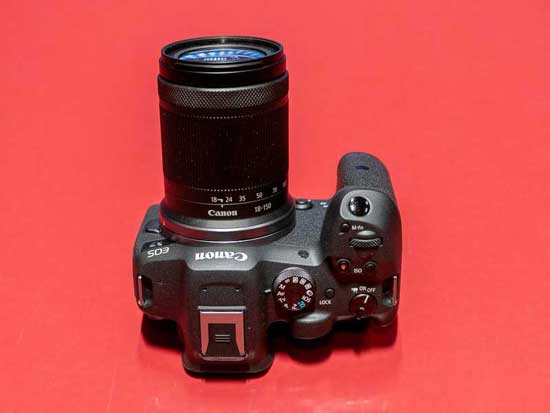
The Canon R6 benefits from using the LP-E6NH, a recently introduced longer life battery that is also supplied with both the EOS R6 and EOS R5 cameras.
The LP-E6NH effectively replaces the existing LP-E6N, reaching 2130mAh and offering an increased capacity of 14%. In reality this translates into 500 shots when using the EVF and 770 when using the LCD screen.
Thankfully it’s also backwards compatible with all existing cameras that use the LP-E6 series batteries,so you can use an older LP-E6N in the EOS R7, and the new LP-E6NH in an older EOS camera that uses the LP-E6N. All of the various chargers are cross-compatible too.
Unfortunately and somewhat bizarrely for such a speed-oriented camera, Canon have chosen not to make a battery grip available for the EOS R7, or even provide the grip positioning holes in the base for any future release.
As well as making the camera easier to use in portrait mode and/or for users with larger hands, it would also have greatly extended the battery life, all things that this camera’s target audience would have benefited from.
With built-in Bluetooth Low Energy and both 2.4Ghz and faster 5Ghz Wi-Fi support, the EOS R7 can be easily connected to a smartphone and networks allowing high-speed file sharing and FTP/FTPS transfer.
The R7 can also be remotely controlled and even updated using Canon’s Camera Connect and EOS Utility apps and tethered to to an Apple iPhone via its Lightning port or a PC or Mac via Wi-Fi or high-speed USB-C 3.2. Live streaming to YouTube is also supported via wi-fi and Canon’s image.canon service.
Image Quality
All of the sample images in this review were taken using the 32.5 megapixel Fine JPEG setting, which gives an average image size of around 8Mb.
The Canon EOS R7 produced still images of excellent quality during the review period.
This camera produces noise-free JPEG images from ISO 100 all the way up to ISO 3200, with noise first appearing at ISO 6400. The faster settings of 12800 and especailly ISO 25600 display progressively more noise, but are still suitable for small prints and web images. We wouldn’t advise using the expanded setting of ISO 51200 though.
The RAW files were also excellent, exhibiting more noise than their JPEG counterparts but still producing very usable images from ISO 100-3200.
The night photograph was very good, with the maximum shutter speed of 30 seconds and the Bulb mode allowing you to capture enough light in all situations, while the HDR mode works well in the right situations.
The various different Picture Styles and the ability to create your own are a real benefit, as are the extensive range of Creative Effects, all of which can be previewed before you take the shot.
Noise
ISO sensitivity can be set between ISO 100 and ISO 51200 in full-stop increments. Here are some 100% crops which show the noise levels for each ISO setting, with JPEG on the left and the RAW equivalent on the right.
| JPEG | RAW |
|
ISO 100 |
ISO 100 |
 |
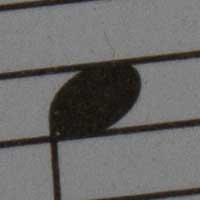 |
|
ISO 200 |
ISO 200 |
 |
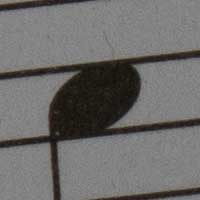 |
|
ISO 400 |
ISO 400 |
 |
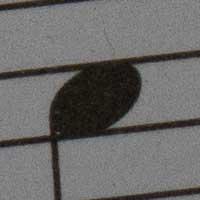 |
|
ISO 800 |
ISO 800 |
 |
 |
|
ISO 1600 |
ISO 1600 |
 |
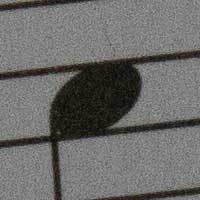 |
|
ISO 3200 |
ISO 3200 |
 |
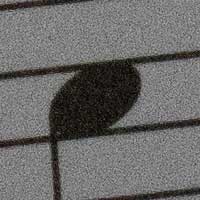 |
|
ISO 6400 |
ISO 6400 |
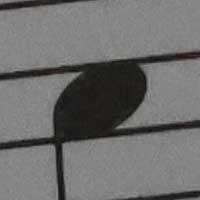 |
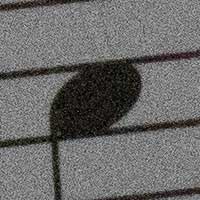 |
|
ISO 12800 |
ISO 12800 |
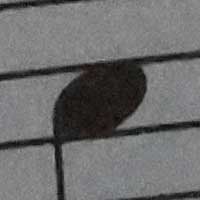 |
 |
|
ISO 25600 |
ISO 25600 |
 |
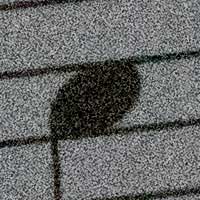 |
|
ISO 51200 |
ISO 51200 |
 |
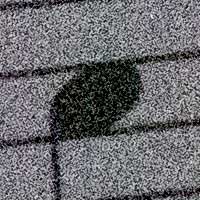 |
File Quality
The Canon EOS R7 has 2 different JPEG file quality settings available, with Fine being the highest quality option, and it also supports Raw and HEIF file formats. Here are some 100% crops which show the quality of the various options, with the file size shown in brackets.
|
Fine (8.4Mb) (100% Crop) |
Normal (4.3Mb) (100% Crop) |
 |
 |
|
Raw (36Mb) (100% Crop) |
|
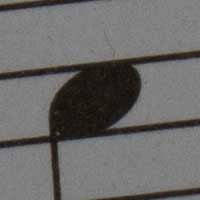 |
Night
The Canon EOS R7’s maximum shutter speed is 30 seconds and there’s a Bulb mode for even longer exposures, which is excellent news if you’re seriously interested in night photography.

HDR
The Canon EOS R7 has a High Dynamic Range mode with four different settings – AUTO, +-1 EV, +-2 EV and +-3 EV. The camera takes three shots with different exposures, changing the shutter speed for each one, and then combining them in-camera.
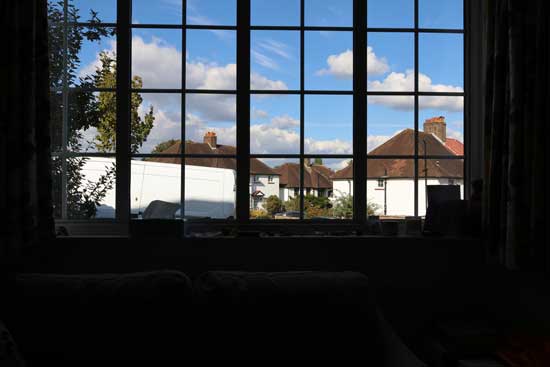
Off
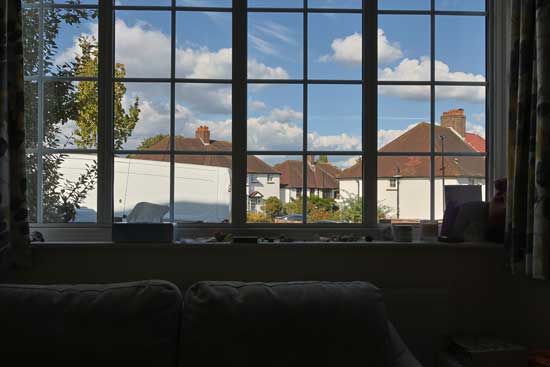
+1EV
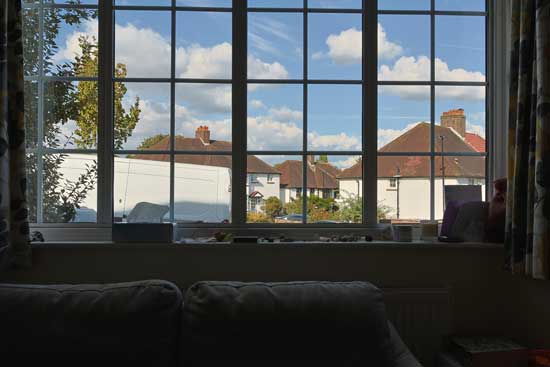
+2EV
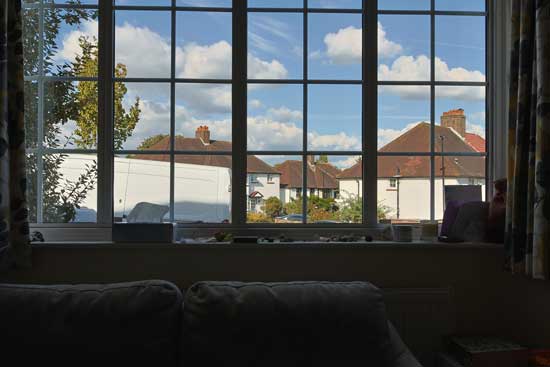
+3EV
Multi Exposure
The Canon EOS R7’s Multiple Exposure mode combines up to 9 different images together in-camera to create one composite image, with four different ways of combining them – Additive, Average, Bright, Dark.
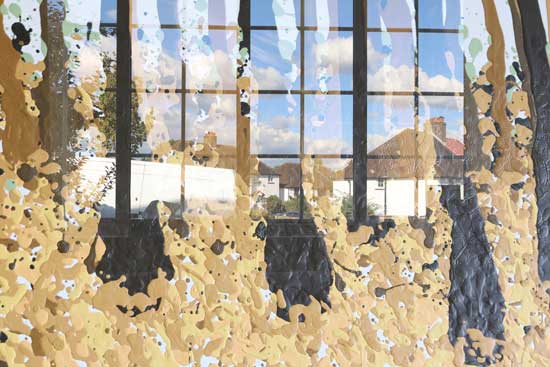
Picture Styles
Canon’s Picture Styles are preset combinations of different sharpness, contrast, saturation and colour tone settings which can be applied to both JPEGs and RAW files. The seven available options are shown below in the following series, which demonstrates the differences. There are also three User Defined styes so that you can create your own look.
|
Standard |
 |
|
Portrait |
 |
|
Landscape |
 |
|
Fine Detail |
 |
|
Neutral |
 |
|
Faithful |
 |
|
Monochrome |
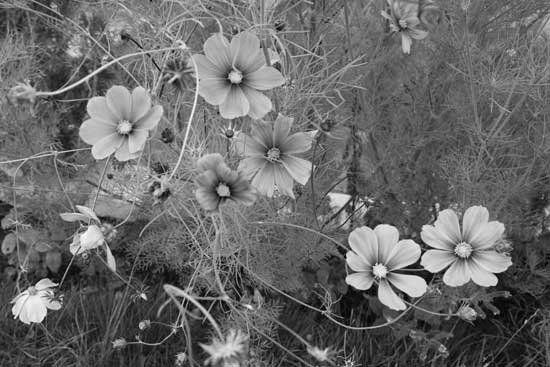 |
Creative Filters
The Creative Filters shooting mode offers 10 different options to help spice up your JPEG images.
Sample Images
This is a selection of sample images from the Canon EOS R7 camera, which were all taken using the 32.5 megapixel Fine setting. The thumbnails below link to the full-sized versions, which have not been altered in any way.
Sample RAW Images
The Canon EOS R7 enables users to capture RAW and JPEG format files. We’ve provided some Canon RAW (CR3) samples for you to download (thumbnail images shown below are not 100% representative).
Sample Movies & Video
This is a sample 4K movie at the quality setting of 3840×2160 pixels at 60 frames per second. Please note that this 13 second movie is 362Mb in size.
This is a sample 4K movie at the quality setting of 3840×2160 pixels at 30 frames per second. Please note that this 14 second movie is 196Mb in size.
This is a sample 4K movie at the quality setting of 3840×2160 pixels at 60 frames per second. Please note that this 15 second movie is 430Mb in size.
This is a sample 4K Fine movie at the quality setting of 3840×2160 pixels at 30 frames per second. Please note that this 15 second movie is 429Mb in size.
This is a sample 4K Crop movie at the quality setting of 3840×2160 pixels at 30 frames per second. Please note that this 15 second movie is 421Mb in size.
This is a sample 1080p slow-motion movie at the quality setting of 1920×1080 pixels at 120 frames per second. Please note that this 43 second movie is 155Mb in size.
Product Images


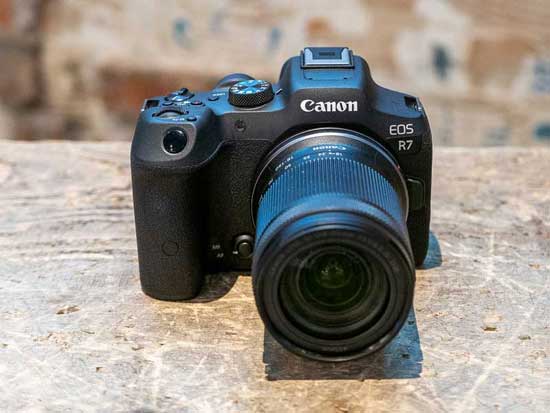
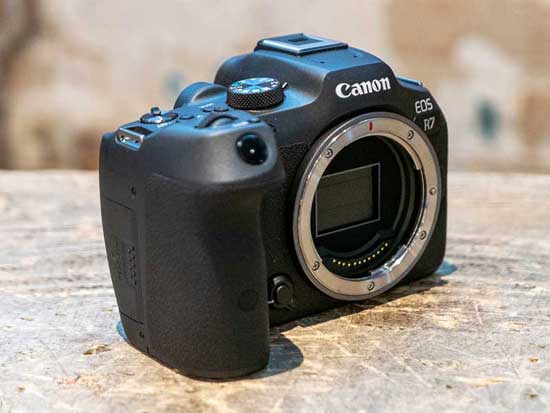
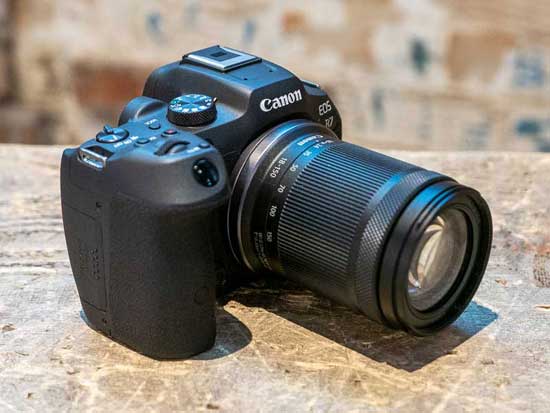
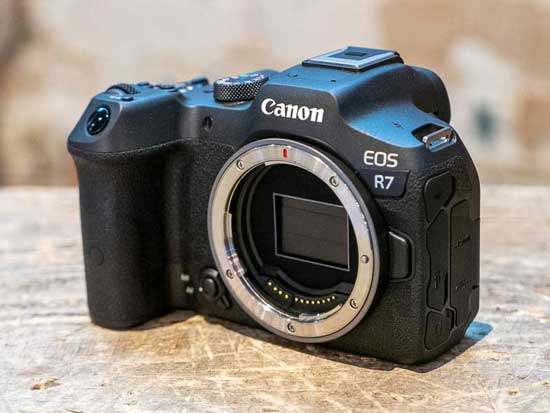



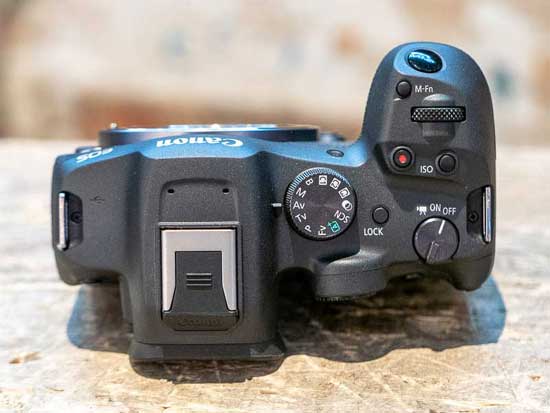


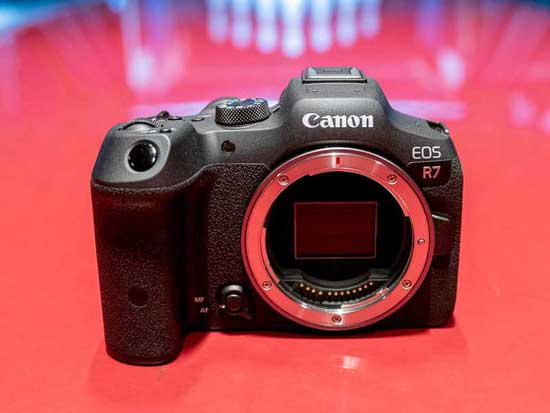
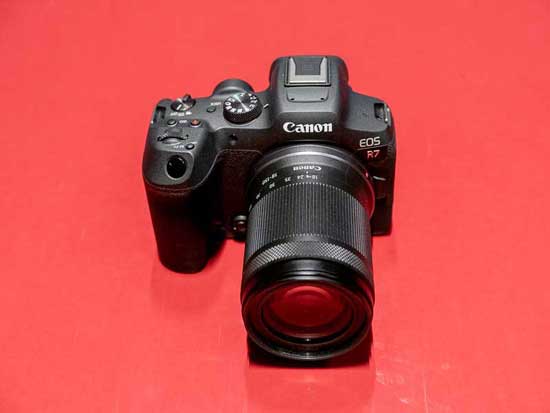
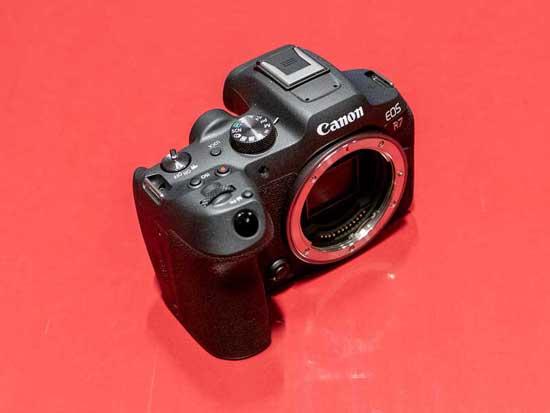
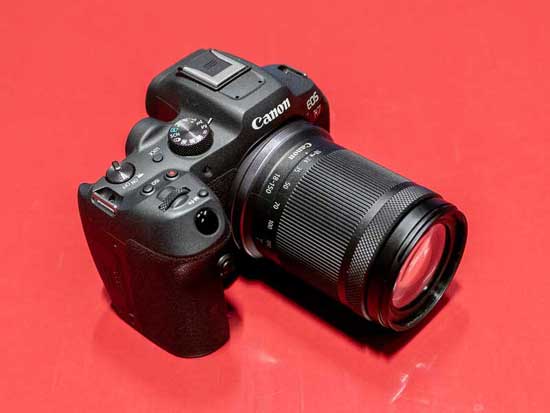
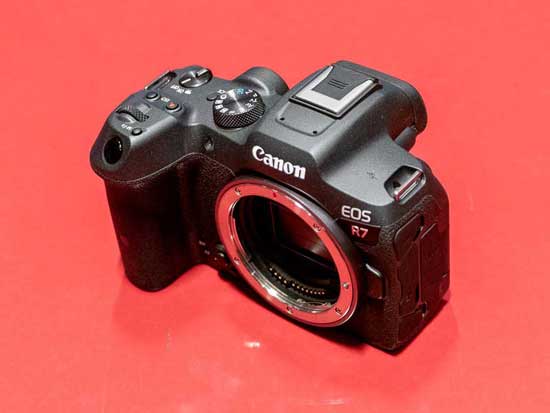
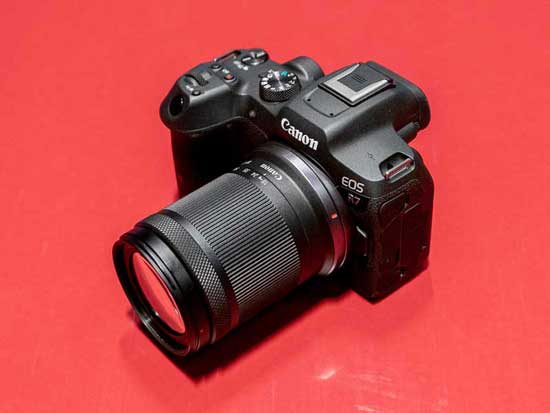
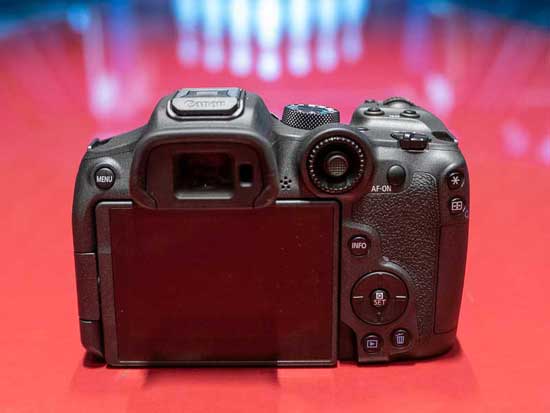
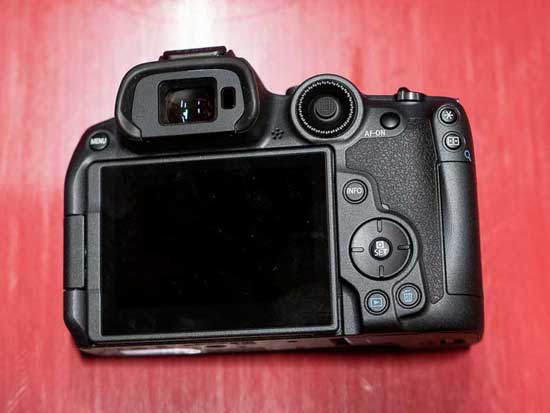
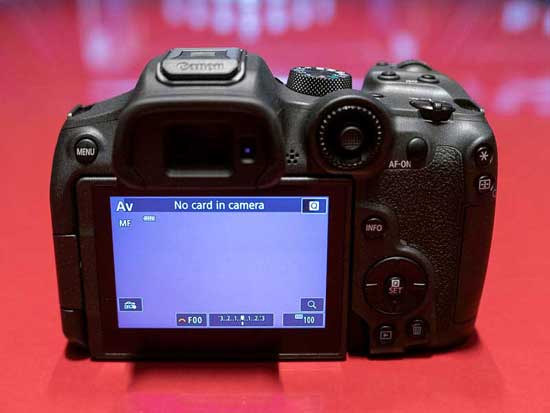
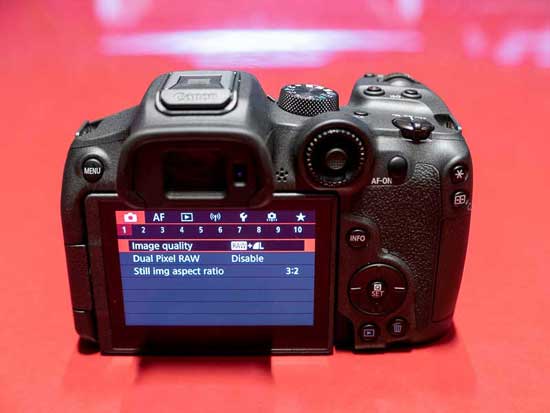
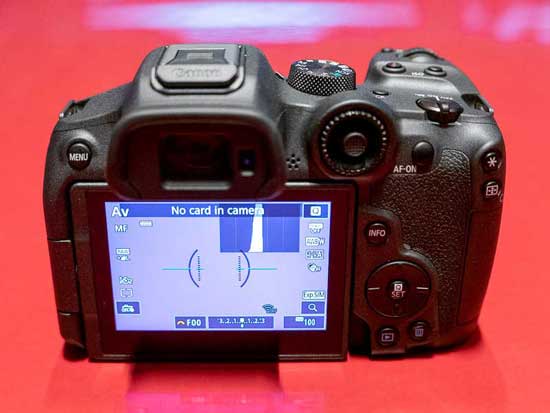

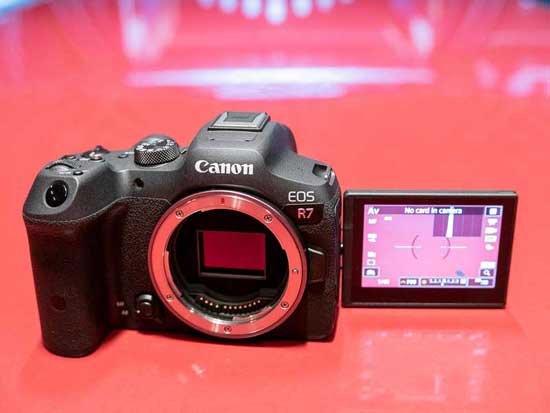

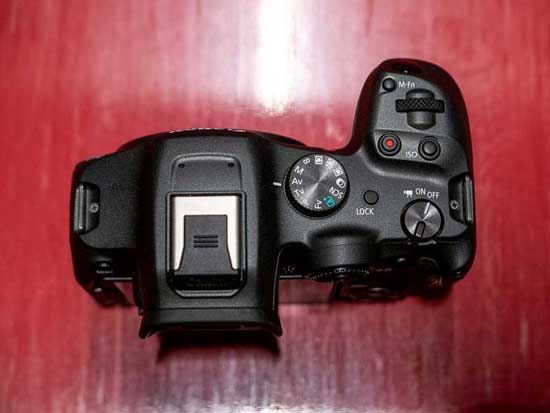


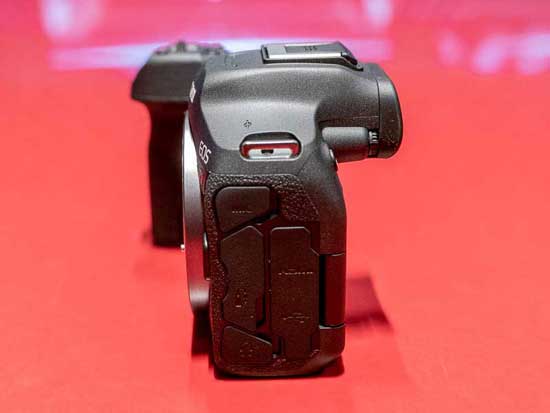


Conclusion
Canon have always been somewhat half-hearted about their long-running but little-supported EOS-M series, so it’s great to see them finally showing the APS-C format some love with the launch of the excellent EOS R7, even if it will probably come at the literal cost of the former system.
Having concentrated almost exclusively on delivering full-frame mirrorless for the last few years, now the Japanese giant has turned its attention to the more affordable end of the market with the launch of the R7 and cheaper R10.
Which isn’t to say that the EOS R7 is a budget option – indeed, it competes directly against some high-end rivals from other manufacturers, most notably the Fujifilm X-T4, although that particular model has itself been recently surpassed by the X-H2 and X-H2S.
The R7 combines a more affordable APS-C sensor with lots of technologies and ideas that have trickled down from higher up the full-frame food chain, most notably the superlative Dual Pixel CMOS AF II autofocus system and fast burst rates, both of which make the R7 a great wildlife and sports camera.
Add in 4K/60p video with no crop, up to 8-stops of image stabilisation and a 32.5 megapixel, high-resolution sensor, and you have a very capable all-rounder that out-performs all previous Canon APS-C cameras, either DSLRs or mirrorless, and is also a very worthy alternative to the full-frame EOS R and RP models.
Our main bugbear is not with the R7 and R10 cameras themselves, but rather the lens support, or lack of it. OK, so the EOS RF-S mount is still very much in its infancy, but it would have been nice to see Canon offering something more interesting than two slow zoom lenses from day one, even if they are very affordable.
You can use Canon’s adapter to mount their vast range of full-frame EF DSLR and RF mirrorless lenses on the R7, but that perhaps rather negates the point of buying a smaller sensor, physically smaller and financially smaller camera. Although if you’ve already heavily invested in some quality RF glass and want the extra reach that mounting those lenses on an APS-C sensor camera offers, the R7 will prove to be a very welcome addition to the R-series family.
It also seems that Canon’s engineers can’t help but tinker with a user interface that has been finely honed over the years, in this case with the debut of the combined AF point selector and rear control wheel. Just like the EOS R’s quirky M-Fn selector that people loved to hate, we can’t help but feel that this new control is trying to solve a problem that didn’t really exist, to the detriment of the overall handling of the camera.
The specs of the LCD screen and EVF are nothing to write home about and the low level of weather-proofing is disappointing on a camera that begs to be used in more inclement conditions, not helped by the two RF-S lenses complete lack of sealing. Otherwise, thankfully, the new R7 gets most other things right.
Fujifilm have long been the kings of the prosumer APS-C segment, and with over 40 generally excellent lenses currently available for the X-system, it’s hard to see past the likes of the cheaper X-T3 or more expensive X-T4 or X-H2 in preference to Canon’s new offering simply because of the lens support. Having said that, the R7 does out-perform the cheaper X-T3 whilst significantly undercutting the X-T4 and X-H2 in price.
Ultimately, the Canon EOS R7 proved to be a very capable and well-balanced all-rounder that’s especially well-suited to action photography. Fingers crossed that Canon quickly release some interesting, high-quality lenses to go with it…
| Ratings (out of 5) | |
|---|---|
| Design | 4.5 |
| Features | 4.5 |
| Ease-of-use | 4.5 |
| Image quality | 4.5 |
| Value for money | 4.5 |
Main Rivals
Listed below are some of the rivals of the Canon EOS R7.
The EOS R is Canon’s first ever full-frame mirrorless camera, joining the likes of Sony, Nikon and Panasonic. Can it beat its main rivals, and is it a real alternative to a more traditional DSLR? Find out now by reading our in-depth Canon EOS R review, complete with full-size sample images, videos and more…
The Canon EOS RP camera follows hot on the heels of last year’s EOS R model, offering full-frame mirrorless tech and 4K video recording at an even more affordable price-point than before. Find out just what the cheapest full-frame mirrorless camera on the market is capable of by reading our in-depth Canon EOS RP review, complete with full-size sample JPEG and RAW images, videos and more…
The X-H2 is the highest resolution APS-C camera that Fujifilm have ever released, offering a 40 megapixel BSI sensor that can record 8K/30p video and shoot burst sequences at 20fps. Find out exactly what this new flagship camera is capable of and who it’s aimed at by reading our complete Fuji XH2 review complete with full-size JPEG, Raw and video samples.
The Fujifilm X-S10 mirrorless camera aims to bring the renowned X-series image quality and colour science to a wider audience by being smaller, easier to use and cheaper than the company’s flagship cameras. Does it strike the right balance between simplicity and accessibility? Find out now by reading our in-depth Fuji XS10 review…
The Fujifilm X-T3 is the successor to our Compact System Camera of the Year 2016 award winner, the popular X-T2. Can this new model really improve on what was already an outstanding camera? Find out now by diving into our in-depth Fujifilm X-T3 review…
The Fujifilm X-T4 is the successor to the very popular X-T3, which was released in 2018, principally adding in-body image stabilisation, greatly improved battery life, a quicker and quieter mechanical shutter, enhanced continuous AF and a number of design tweaks. Can the new X-T4 improve on what was already an outstanding camera? Find out now by reading our in-depth Fujifilm X-T4 review…
Nikon have introduced their first APS-C, cropped-sensor mirrorless camera with the launch of the Z50, accompanied by two kit zoom lenses. Can the Z50 take on the likes of the well established Sony A6000-series and Canon EOS-M range, not to mention Fujifilm with its line-up of excellent APS-C bodies and lenses? Find out now by reading our in-depth Nikon Z50 review.
The A6600 is the new all-singing, all-dancing flagship camera in Sony’s extensive range of APS-C mirrorless cameras, but does it offer enough to out-gun both its main rivals and its cheaper siblings? Find out now by reading our in-depth Sony A6600 review, complete with full-size sample images and videos.
Review Roundup
Reviews of the Canon EOS R7 from around the web.
In a long-expected move, Canon has introduced two new mirrorless cameras, the Canon EOS R7 and Canon EOS R10, both employ the APS-C sensor format, but use the same RF lens mount at its full-frame models. This means they’re not part of the EOS M system that Canon has used for APS-C mirrorless until now, and can’t use EF-M lenses.
Read the full review »
In conclusion, the Canon EOS R7 is a lot of camera for a reasonable amount of money. It has a lot going for it, from the blistering burst rate in either mechanical (3FPS faster than the EOS R3) or electronic shutter mode to the excellent, high resolution 32.5MP sensor. This is a tool that makes it easy to capture images in a wide variety of situations.
Read the full review »
The R7, like the 7D II, arrived to extreme popularity, especially for its performance to price ratio. While the R7 has great general-purpose utility, wildlife and sports photographers will especially be attracted to this camera’s capabilities and features, including its dense imaging sensor’s reach. The R7 removes the few remaining excuses to remain on a DSLR platform.
Read the full review »
Specifications
Image Sensor
- Type Approx. 22.3 × 14.8 mm (APS-C) CMOS
- Effective Pixels 32.5MP
- Total Pixels 34.4MP
- Aspect Ratio 3:2
- Low-Pass Filter Built-in/Fixed
- Sensor Cleaning EOS integrated cleaning system
- Colour Filter Type Primary Colour
- Sensor Shift-IS Yes, up to 8-stops advantage depending on the lens used.
7-stops with the RF-S 18-150mm F3.5-6.3 IS STM
Image Processor
Lens
- Lens Mount RF (natively supporting RF and RF-S lenses)
EF and EF-S lenses can be attached using Mount Adapter EF-EOS R, EF-EOS R Control Ring Mount Adapter, Drop-in Filter Mount Adapter EF-EOS R
EF-M lenses are not compatible - Focal Length Equivalent to 1.6x the focal length of the lens with RF/RF-S and EF/EF-S lenses
- Image Stabilisation Supported, with combination of Sensor Shift-IS
Focusing
- Type Dual Pixel CMOS AF II
- AF System / Points With Area 100% horizontal and 100% vertical (Auto selection)
90% horizontal and 100% vertical (Manual selection) - AF Working Range EV -5 – 20 (at 23°C & ISO100)
- AF Modes One Shot
Servo AF
Auto Switch (only in A+ mode) - AF Point Selection Automatic selection: 651 Available AF areas when automatically selected
Manual selection: 1-point AF (AF frame size can be changed) 5915 AF positions available stills ( 4823 Movies)
Manual selection: AF point Expansion 4 points (up, down, left, right)
Manual selection: AF point Expansion surrounding
Manual selection: Flexible Zone AF 1-3 (all AF points divided into minimum 9 to 567 maximum focusing zones)
Manual selection: Whole Area AF (Entire focusing area with 651 maximum focusing zones) - AF Tracking Humans (Eyes/Face/Head/Body), Animals (Dogs, Cats and Birds) or Vehicles (Racing cars or Motor bikes)
- AF Lock Locked when shutter button is pressed halfway or AF ON is pressed in One Shot AF mode. Using customised button set to AF stop in AI servo
- AF Assist Beam Emitted by built in LED or optional dedicated Speedlite (flash)
- Manual Focus Selected on lens/camera
Exposure Control
- Metering Modes Real-time with image sensor, 384-zone metering.
(1) Evaluative metering (linked to All AF points)
(2) Partial metering (Approx. 6% of viewfinder at centre)
(3) Spot metering: Centre spot metering (Approx. 3% viewfinder at centre) AF point-linked spot metering not provided
(4) Centre weighted average metering - Metering Brightness Range EV -2 – 20 (at 23°C, ISO100, with evaluative metering)
- AE Lock Auto: AE lock takes effect when focus is achieved (AE is locked as soon as subjects are in focus using One-Shot AF when set to [C.Fn 2: AE lock meter. mode after focus].)
Manual: By AE lock button in P, Av, Fv, Tv and M modes - Exposure Compensation +/-3 EV in 1/3 or 1/2 stop increments (can be combined with AEB)
- AEB +/-3 EV in 1/3 or 1/2 stop increments
- Anti-flicker Shooting Yes. Flicker detected at a frequency of 100 Hz or 120 Hz.
- ISO Sensitivity Auto 100-32000 (in 1/3-stop or whole stop increments)
ISO can be expanded to H: 51200
Shutter
- Type Electronically controlled focal-plane shutter and Electronic shutter function in sensor
- Speed Mechanical: 30-1/8000 sec (1/2 or 1/3 stop increments), Bulb, Electronic: 30-1/16000 (1/2 or 1/3 stop increments up to 1/8000 then 1 stop until 1/16000) (Total shutter speed range. Available range varies by shooting mode)
- Shutter Release Soft-touch electromagnetic release
White Balance
- Type Auto white balance with the imaging sensor
AWB (Ambience priority/White priority), Daylight, Shade, Cloudy, Tungsten light, White Fluorescent light, Flash, Custom, Colour Temperature Setting - Settings White balance compensation:
1. Blue/Amber +/-9
2. Magenta/Green +/-9 - Custom White Balance Yes, 5 setting can be registered
+/-3 levels in single level increments - WB Bracketing 3, 2, 5 or 7 bracketed images per shutter release
Selectable Blue/Amber bias or Magenta/Green bias
Viewfinder
- Type 0.39 inch OLED colour EVF
- Dot Count 2.36 Million dots (1024×768)
- Coverage (Vertical/Horizontal) Approx. 100%
- Magnification Approx. 1.15x>
- Eyepoint Approx. 22mm (At -1 m-1 from eyepiece lens end)
- Dioptre Correction -4 to +2 m-1 M (dioptre)
- Display Performance Power saving: 59.94 fps Smooth 119.98 fps
- Viewfinder Information Accessory attached indicator, AE lock, AEB, AF area, AF method, AF operation, AF point (1-point AF), AF point information, Anti-flicker shooting, Aperture value, Aspect ratio, Audio recording level (manual), Audio recording level indicator (manual), Auto Lighting Optimizer, Battery level, Bluetooth function, Canon Log, Card for recording/playback, Creative filters, Bulb timer, Digital Lens Optimizer, Digital zoom, Drive mode, Electronic level, Electronic shutter, Exposure compensation, Exposure level indicator, Exposure simulation, FE lock, FEB, Flash off, Flash-ready, Focus bracketing, focus distance scale, GPS, Grid, HDR PQ, HDR shooting, Headphone volume, Highlight tone priority, High-speed sync, Histogram (Brightness/RGB), Image Quality, Image Stabilizer (IS mode), Interval timer, ISO speed, Lens information, Magnify button, Maximum burst, Metering mode, Movie recording in progress, Movie recording size, Movie recording time available, Movie recording time available/Elapsed recording time, Movie self-timer, Movie Servo AF, Multi Shot Noise Reduction, Multi Shot Noise Reduction, Multi-function lock warning, Multiple-exposure shooting, No. of remaining shots for focus bracketing, Number of available shots/Sec. until self-timer shoots, Number of remaining multiple exposures, Number of self-timer shooting, Overheat control, Picture Style, Quick Control button, Shooting mode, Shutter speed, Still photo cropping, Subject to detect, Touch Shutter/Create folder, vertical exposure scale, View Assist, White balance, White balance correction, Wi-Fi function, Wi-Fi signal strength
- Depth of Field Preview Yes, via customised button
LCD Monitor
- Type 7.5 cm (2.95″) TFT colour LCD monitor, Approx. 1.62 million dots
- Coverage Approx. 100%
- Viewing Angle (Horizontally/Vertically) Approx. 170° vertically and horizontally
- Coating Anti-smudge.
- Brightness Adjustment Manual: Adjustable to one of seven levels
Colour Tone Adjustment: 4 settings - Touch Screen Operations Capacitive method with menu functions, Quick Control settings, playback operations, and magnified display. AF point selection in still and Movies, touch shutter is possible in still photo shooting.
- Display Options (1) Basic Camera settings
(2) Advance Camera settings
(3) Camera settings plus histogram and dual level display
(4) No info
(5) Quick Control Screen
(6) Display off
Flash
- Modes E-TTL II Auto Flash, Metered Manual
- X-Sync 1/250 sec. mechanical shutter
1/320 sec. electronic 1st curtain
Flash photography is not available with Electronic shutter. - Flash Exposure Compensation +/- 3EV in 1/3 increments with EX series Speedlite flashes
- Flash Exposure Bracketing Yes, with compatible External Flash (+/- 3EV in 1/3- or 1/2-stop increments with EX/EL series Speedlite flashes)
- Flash Exposure Lock Yes
- Second Curtain Synchronisation Yes, via Speedlite
- HotShoe / PC Terminal Yes/No
- External Flash Compatibility E-TTL II with EX/EL series Speedlite, wireless multi-flash support
- External Flash Control via camera menu screen
Shooting
- Modes Stills: Scene Inteligent Auto, 13 Special Scene modes(including Panning/Panoramic Shot), Creative Filters, Flexible priority AE, Program AE, Shutter priority AE, Aperture priority AE, Manual, Bulb and Custom (x3)
Movie: Scene Inteligent Auto movies, HDR Movies, Creative Filters, Movie Auto Exposure, Shutter priority AE, Aperture priority AE, Manual, and Custom (x3) - Picture Styles Auto, Standard, Portrait, Landscape, Fine Detail, Neutral, Faithful, Monochrome, User Defined (x3)
- Colour Space sRGB and Adobe RGB / Fixed at HDR PQ
Highlight Tone Priority (3 settings)
Auto Lighting Optimizer (4 settings)
Long exposure noise reduction (3 settings)
High ISO speed noise reduction (4 settings) (still and video)
Clarity (+/- 4)
Lens optical correction:
– Peripheral illumination correction, Chromatic aberration correction, Distortion correction (during/after still photo shooting, during video only)
– Diffraction correction, Digital Lens Optimizer (during/after still photo shooting) - Image Processing Resize JPEG / HEIF images to M, S1, S2
Cropping: JPEG / HEIF images can be cropped (Aspect ratios 3:2, 4:3, 16:9, 1:1)
Cropping of images
– Switch between vertical and horizontal cropping orientation
– Image straightening
– Cropping frame can be moved using touch screen operation
RAW image processing
Cloud RAW image processing
Multiple exposure
HDR
HEIF to Jpeg conversion - Drive Modes Single, Continuous High+, Continuous High, Continuous Low, Self-timer (2s+remote, 10s+remote, continous)
- Continuous Shooting Max. Approx. 15 FPS with Mechanical shutter/1st curtain electronic shutter the speed maintained for 224 JPEG or 51 RAW images
Max. Approx. 30 FPS with Electronic shutter the speed maintained for 126 JPEG or 42 RAW images - Interval Timer Built in
File Type
- Still Image Type RAW 14 bit: RAW and C-RAW (Canon original RAW 3rd edition)
JPEG 8 bit: 2 compression options
HEIF 10 bit: 2 compression options
Complies with Exif 2.31 and Design rule for Camera File system 2.0
Complies with Digital Print Order Format [DPOF] Version 1.1 - RAW+JPEG Simultaneous Recording Yes, any combination of RAW + JPEG or RAW + HEIF possible
- Image Size RAW/ C-RAW:
3:2 ratio 6960×4640
JPEG/ HEIF:
3:2 ratio (L) 6960×4640, (M) 4800×3200, (S1) 3472×2320, (S2) 2400×1600
4:3 ratio (L) 6160×4640, (M) 4256×3200, (S1) 3072×2320, (S2) 2112×1600
16:9 ratio (L) 6960×3904, (M) 4800×2688, (S1) 3472×1952, (S2) 2400×1344
1:1 ratio (L) 4640×4640, (M) 3200×3200, (S1) 2320×2320, (S2) 1600×1600 - Folders New folders can be manually created, named and selected
- File Numbering (1) Continouos numbering
(2) Auto reset
(3) Manual reset - File Naming 2 User presets
EOS Movie
Other Features
- Custom Functions 19 custom functions + button and dial customisations
- Metadata Tag User copyright information (can be set in camera)
- LCD Panel / Illumination No
- Water/Dust Resistance Yes
- Voice Memo No
- Intelligent Orientation Sensor Yes
- Playback Zoom 1.5x – 10x in 15 steps
- Display Formats (1) Single image
(2) Single image with information (2 levels)
Basic – Shooting information (shutter speed, aperture, ISO and Image quality)
Detailed – Shooting information (shutter speed, aperture, ISO, metering Image, quality and file size), Lens information, Brightness and RGB histogram, White balance, Picture Style, Color space and noise reduction, Lens optical correction, GPS information
(3) 4 image index
(4) 9 image index
(5) 36 image index
(6) 100 image index
(7) Jump Display (1, 10 or Custom(30) images, start of burst sequence Date, Folder, Movies, Stills, Protected images, Rating)
(8) Movie edit
(9) RAW processing
(10) Rating - SlideShow Image selection: All images, by Date, by Folder, Movies, Stills, Protected images or Rating
Playback time: 1/2/3/5/10 or 20 seconds
Repeat: On/Off - Histogram Brightness: Yes
RGB: Yes - Highlight Alert Yes
- Image Erase Single image, select range, Selected images, Folder, Card
- Image Erase Protection Erase protection of Single image, Folder or Card all found images (only during image search)
- Self Timer 2 or 10 sec.
- Menu Categories (1) Shooting menu
(2) AF Menu
(3) Playback menu
(4) Network
(5) Setup menu
(6) Custom Functions menu
(7) My Menu - Menu Languages 29 Languages
English, German, French, Dutch, Danish, Portuguese, Finnish, Italian, Norwegian, Swedish, Spanish, Greek, Russian, Polish, Czech, Hungarian, Vietnamese, Hindi, Romanian, Ukrainian, Turkish, Arabic, Thai, Simplified Chinese, Traditional Chinese, Korean, Malay, Indonesia and Japanese - Firmware Update Update possible by the user (Camera, Lens, External Speedlite, BLE remote control, Lens adapter, multi-function shoe accessories)
Interface
- Computer SuperSpeed Plus USB 3.2 Gen 2 USB Type-C connector also used for computer communication / smartphone communication / USB power.
- Wi-Fi Wireless LAN (IEEE802.11b/g/n) (2.4 GHz), with Bluetooth 4.2 support Features supported – EOS Utility, Smartphone, Upload to image.canon, Wireless printing
- Other HDMI Micro out (Type D, HDMI-CEC not supported)
External Microphone In (3.5mm Stereo mini jack)
Headphone socket (3.5mm Stereo mini jack)
RS-60E3-type terminal (remote control terminal)
Direct Print
- Canon Printers Canon Compact Photo Printers and PIXMA Printers supporting PictBridge via wireless LAN
- PictBridge Yes (via Wireless LAN)
Storage
- Type 2x SD/SDHC/SDXC and UHS-II
Supported Operating System
- PC Windows 8.1 / Windows 10 (tablet mode not supported) / Windows 11
- Macintosh OS X 10.14, 10.15, OS 11.4, 12
Software
- Image Processing Digital Photo Professional 4.16.10 or later
Digital Photo Professional Express mobile app (iOS only) - Other EOS Utility 3 (incl. Remote Capture), Picture Style Editor, EOS Lens Registration Tool, Canon Camera connect app (iOS/Android)
Power Source
- Batteries Rechargeable Li-ion Battery LP-E6NH (supplied) , LP-E6N, LP-E6
- Battery Life With LCD Approx. 770 shots (at 23°C)
With Viewfinder Approx. 500 shots (at 23°C) - Battery Indicator 6 levels + percentage
- Power Saving Screen dimmer: 5 sec. / 10 sec. / 15 sec. / 20 sec. /25 sec. / 30 sec. / Disable
Screen off: 5 sec. / 15 sec. / 30 sec. / 1 min. / 3 min. / 5 min. / 10 min. / 30 min. / Disable
Auto power off: 15 sec. / 30 sec. / 1 min. / 3 min. / 5 min. / 10 min. / 30 min. / Disable
Viewfinder off: 1 min. / 3 min. / Disable - Power Supply & Battery Chargers Battery charger LC-E6E (supplied), AC Adapter AC-E6N and DC Coupler DR-E6, PD-E1 USB power adapter
Accessories
- Wireless File Transmitter None
- Cases / Straps An included strap, Hand Strap E2
- Lenses All RF and RF-S lenses (EF & EF-S via Lens adapters)
- Lens Adapters Mount Adapter EF-EOS R, EF-EOS R Control Ring Mount Adapter, Drop-in Filter Mount Adapter EF-EOS R
- Flash Canon Speedlite (EL-1*, EL-100, 90EX, 220EX, 270EX, 270EX II, 320EX, 380EX, 420EX, 430EX, 430EX II, 430EX III 470EX-AI, 550EX, 580EX*, 580EX II*, 600EX*, 600EX-RT*, 600EX-II-RT*, Macro-Ring-Lite MR-14EX, Macro Ring Lite MR-14EX II, Macro Twin Lite MT-24EX, Macro Twin Lite MT-26EX-RT, Speedlite Transmitter ST-E2, Speedlite Transmitter ST-E3-RT*, Speedlite Transmitter ST-E3-RT V2*, Speedlite Transmitter ST- E10, Off-Camera Shoe Cord OC-E3*)
*Must use Multi-Function Shoe Adapter AD-E1 to retain weather sealing - Remote Controller / Switch RS-60E3-type terminal (remote control terminal), Timer Remote Controller TC-80N3, Wireless Remote Control BR-E1, Infrared Remote Controller RC-6, Smartphone(Using Canon Camera Connect app)
- Other Shoe cover(Included), Multi-Function Shoe Adapter AD-E1, Multi-Function Shoe Directional Stereo Microphone DM-E1D, Multi-Function Shoe Adapter for Smartphone Link AD-P1 for Android, Stereo Microphone DM-E1 / DM-E100, GPS Receiver GP-E2, Tripod grip HG-100TBR, Interface Cable IFC-100U, Interface Cable IFC-400U, Protecting Cloth PC-E1 / E2
Physical Specifications
- Body Materials Primarily consists of a magnesium alloy and high-strength engineering plastic
- Operating Environment 0 – 40 °C, 85% or less humidity
- Dimensions (W x H x D) Approx. 132.0 x 90.4 x 91.7 mm
- Weight (Body Only) Approx. 530 g (612g with card and battery, Based on CIPA guidelines.)
- Yaw/Pitch direction, based on the CIPA standard, 8.0 stops with RF 24-105mm F4 L IS USM at a focal distance of 105mm. Depending on the time of purchase, the lens firmware needs to be updated. For details on supported lenses, refer to Supplemental Information of EOS R7 on the website “cam.start.canon”.
- During still photo shooting, with an f/1.2 lens, Centre AF point, One-Shot AF, at 23°C/73°F, ISO100. Excluding RF lenses with Defocus Smoothing coating
- 7-stops based on the CIPA standard with RF-S 18-150mm F3.5-6.3 IS STM at a focal length of 150mm
- Continuous shooting speed may be slower depending on subject/shooting conditions or the camera setup or the lens used, etc.. Refer to Advanced User Guide for details. For information on lenses that support the maximum continuous shooting speed with servo AF, refer to Supplemental Information of EOS R7 on the website “cam.start.canon”. Depending on the nature of subject or shooting conditions, rolling shutter image distortion may occur.
- The operation of the RF 5.2 mm F 2.8 L DUAL FISHEYE is not guaranteed. Excluding EF-M lenses. Operation of EF Cinema Lens is not guaranteed. Operation of the mount adapter EF-EOS R 0.71 X (sold separately) is not guaranteed.
- Applicable when subject frame is shown while tracking and a compatible lens is attached to the camera while the full-range AF is active or the subject is detected successfully in another area mode. For details on supported lenses, refer to [Supplemental Information] for EOS R7 in “cam.start.canon”.
- During still photo shooting, with an f/1.2 lens, Centre AF point, One-Shot AF, at 23°C/73°F, ISO100. Excluding RF lenses with Defocus Smoothing coating.
- Camera features a manual focus switch therefore MF can be selected on lens/camera Depending on the lens attached. When RF lenses without a focus mode switch are attached manual focus is selected on the camera. When RF/EF lenses with a focus mode switch are attached, the setting on the lens takes precedence, so the setting of the camera’s focus mode switch has no effect.
- In High frame Rate Movie mode sound is not recorded
- The maximum frame rate during AF, half-press of the shutter button, or continuous shooting is 59.94 fps. Note that the display frame rate may be lower depending on the lens you are using and shooting conditions.
- Only available for mechanical shutter. Maximum continuous shooting speed may decrease. High Frequency anti flicker shooting is not supported.
- ISO is limited to ISO 200–32000 when [Highlight tone priority] is configured. Expanded ISO speeds cannot be set in HDR mode or for HDR shooting (HDR PQ).
- With 3:2 display, an RF 50mm F1.2 L USM lens at infinity, -1 m-1
- Continuous shooting speed may be slower depending on subject/shooting conditions or the battery type/condition or the camera setup or the lens used, etc.. Refer to Advanced User Guide for details. For information on lenses that support the maximum continuous shooting speed with servo AF, refer to Supplemental Information of EOS R7 on the website “cam.start.canon”.
- Under Canon testing standards with 32GB UHS-II card (during One-Shot AF, ISO 100, Standard Picture Style) Number of images depends on various settings and lens used. For details on supported lenses, refer to “cam.start.canon”
- Under Canon testing standards with 32GB UHS-II card (during One-Shot AF, ISO 100, Standard Picture Style) Number of images depends on various settings and lens used. For details on supported lenses, refer to “cam.start.canon”
- Generated from 7K oversampling.
- Playback frame rate; sound is not recorded
- Max. movie contnuous recording time available: Normal: 6 hr. High Frame Rate movie (Full HD 120/100fps): 90 min. If the camera’s internal temperature becomes too high the recording time may reduce. 4K 30p HQ: Approx. 60 min. if starting from +23°C. 4K 60p Crop: Approx. 60 min. if starting from +23°C.
- Movies enabling extraction: 4K Fine / 4K / 4K Crop Extracted still photos cannot be resized or cropped within the camera.
- The default setting range when set to Canon Log 3 is L and ISO 800–12800
- Although the camera is designed to be dustproof and moisture-proof, it cannot guarantee complete exclusion of dust, dirt, water, salt, etc. from entry. To ensure the camera’s dustproof and moisture-proof performance, tightly close opening/closing parts such as terminal cover, battery compartment lid, and card slot cover. Also, attach shoe cover to multi-accessory shoe. When using a conventional accessory equipped with a dustproof, moisture-proof adapter, multi-accessory shoe adapter AD-E1 is required.
- UHS-II high speed cards are recommended for 4K video recording and high speed continous shooting
- With LP-E6NH / LP-E6N, charging over USB is supported. With LP-E6 or unauthenticated batteries, charging over USB is not supported. Batteries may not be charged unless the remaining battery level is low.
- Based on the CIPA Standard and using the battery supplied with the camera, except where indicated. In power saving mode
- If the camera remains idle until the specified time elapses, the screen is dimmed and lower video frame rates are used. [Power off] and [Screen off] can be assigned to buttons using button customization.
- Requires Remote Controller Adapter RA-E3.
- Digital compass not supported. Cannot be connected using an interface cable. Requires Multi-Function Shoe Adapter AD-E1.
- Note that total camera mount load capacity for camera, lens, microphone, and other accessories should not exceed 1 kg /35.3 oz. When using an external microphone, depending on the lens used, the sound may be interrupted by the lens and then the sound may not be properly collected.






